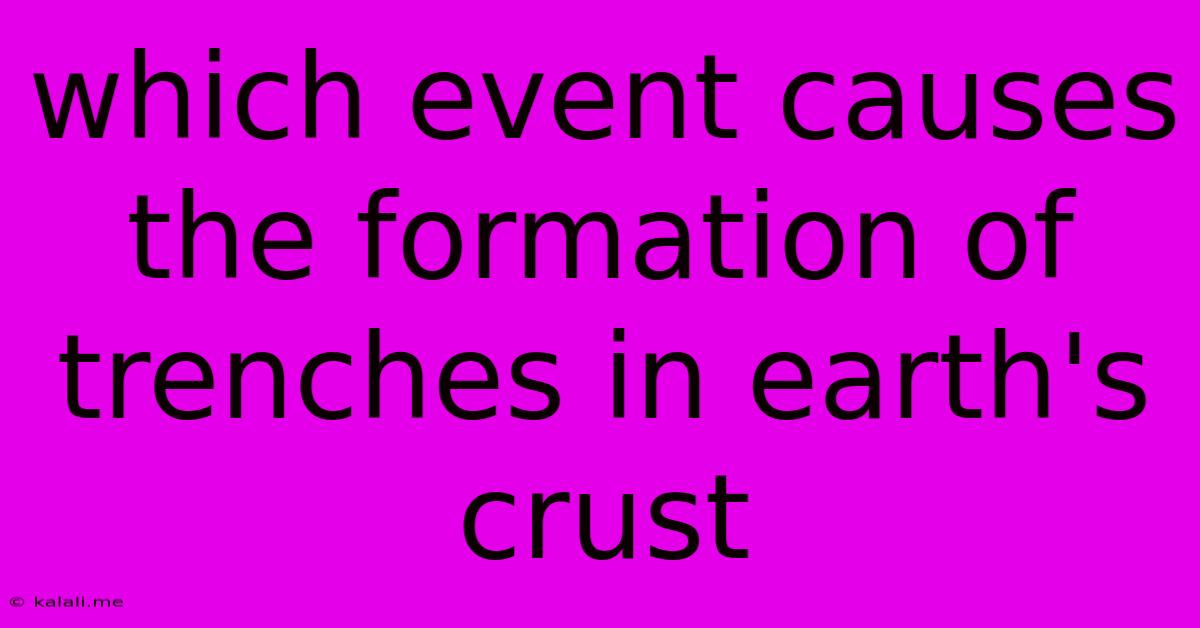Which Event Causes The Formation Of Trenches In Earth's Crust
Kalali
May 10, 2025 · 3 min read

Table of Contents
The Earth's Trenches: A Deep Dive into Plate Tectonics
The dramatic, deep scars etched across the ocean floor—oceanic trenches—are among the most impressive geological features on our planet. These elongated depressions, often exceeding 10,000 meters in depth, are not randomly scattered; their formation is directly linked to a fundamental process shaping the Earth's crust: plate tectonics. This article explores the driving force behind trench formation and the related geological phenomena.
The primary event responsible for the creation of trenches is convergent plate boundaries. This occurs when two tectonic plates collide, resulting in the subduction of one plate beneath the other. Understanding this process is crucial to understanding the formation of these remarkable geological features.
Convergent Plate Boundaries and Subduction: The Key Players
The Earth's lithosphere, the rigid outer layer encompassing the crust and upper mantle, is fragmented into numerous plates constantly in motion. When two plates meet at a convergent boundary, several scenarios can unfold, depending on the type of crust involved (oceanic or continental). However, the formation of trenches is overwhelmingly associated with oceanic-oceanic and oceanic-continental convergence.
-
Oceanic-Oceanic Convergence: In this scenario, two oceanic plates collide. The denser plate, typically the older and colder one, bends and slides beneath the less dense plate in a process called subduction. This downward movement creates a deep, narrow trench at the point of convergence. The subducting plate melts as it descends into the mantle, often leading to volcanic activity and the formation of island arcs (chains of volcanic islands). Examples include the Mariana Trench, the deepest point on Earth, and the Japan Trench.
-
Oceanic-Continental Convergence: Here, an oceanic plate collides with a continental plate. Because oceanic crust is denser than continental crust, the oceanic plate subducts beneath the continental plate. This subduction zone forms a trench along the continental margin. The subduction process can also lead to significant volcanic activity and the formation of mountain ranges on the continental plate. The Andes Mountains in South America are a prime example of this type of convergent boundary.
Other Factors Influencing Trench Formation
While convergent plate boundaries are the primary cause, other factors influence the size, shape, and characteristics of trenches:
-
Plate Convergence Rate: The speed at which plates converge significantly impacts the trench's morphology. Faster convergence rates generally lead to steeper trench slopes and more intense seismic activity.
-
Sedimentation: The accumulation of sediments on the ocean floor can partially fill the trench, modifying its depth and profile. The rate of sedimentation varies depending on the proximity to landmasses and ocean currents.
-
Volcanic Activity: The melting of the subducting plate creates magma that rises to the surface, resulting in volcanic activity near the trench. This volcanic activity can further reshape the trench's structure over geological timescales.
Understanding Trenches: A Window into Earth's Interior
Studying oceanic trenches provides invaluable insights into the Earth's internal processes. The immense pressures and temperatures involved in subduction zones offer clues about the Earth's mantle composition, the dynamics of plate movement, and the processes that generate earthquakes and volcanic eruptions. Analyzing sediments within trenches allows scientists to reconstruct past climate conditions and oceanographic changes.
In conclusion, the formation of trenches is a direct consequence of convergent plate boundaries and the process of subduction. The interaction between oceanic and continental plates, coupled with other factors like convergence rate and sedimentation, shapes these dramatic features of the Earth's crust, providing a crucial window into the dynamic and powerful forces that shape our planet.
Latest Posts
Latest Posts
-
What Is 20 Percent Of 800 000
Jul 12, 2025
-
Words That Start With Y In Science
Jul 12, 2025
-
Prevent An Expressway Emergency By Merging Without
Jul 12, 2025
-
How Many Grams Of Sugar In A Pound
Jul 12, 2025
-
7am To 11am Is How Many Hours
Jul 12, 2025
Related Post
Thank you for visiting our website which covers about Which Event Causes The Formation Of Trenches In Earth's Crust . We hope the information provided has been useful to you. Feel free to contact us if you have any questions or need further assistance. See you next time and don't miss to bookmark.